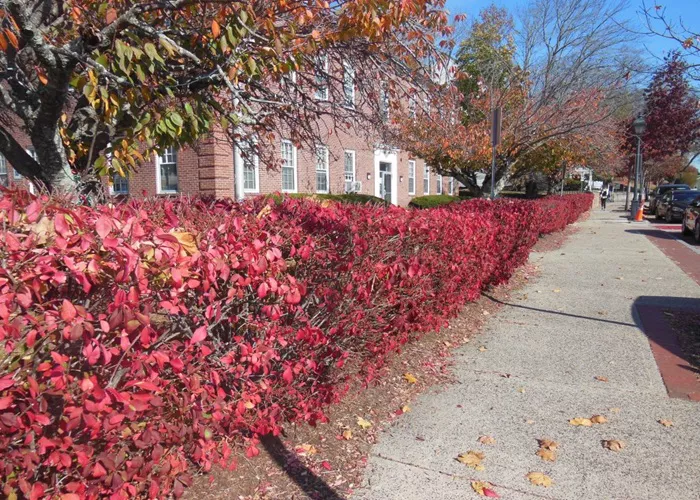Hingham, known for its title as a “Tree Town,” is now facing a pressing environmental challenge. The town, which has long celebrated its commitment to greenery, must address a growing issue with invasive species that threaten local ecosystems. One such plant, the Burning Bush (Euonymus alatus), has become widespread in the town, and experts are urging residents and town officials to take action.
The Burning Bush, which is known for its striking red foliage in the fall, is listed on the Massachusetts Invasive Plant List. Plants on this list are prohibited from being sold, bought, or given away in the state. The Massachusetts Invasive Plant List, along with a detailed explanation of prohibited species, can be accessed online at Massachusetts Invasive Plant List and Massachusetts Prohibited Plant List.
Across Hingham, the Burning Bush has become a common sight, particularly along Main Street from Hingham Square to Queen Anne’s Corner, where roughly 25 of these shrubs or hedges line the streets. While their red color may be aesthetically pleasing, Burning Bush plants are invasive, and many residents may not be aware of the harm they cause to local biodiversity.
As climate change continues to impact ecosystems, experts emphasize the importance of preserving native plants, insects, and wildlife. Invasive species, like the Burning Bush, pose a serious threat to native flora and fauna. These non-native plants have no natural predators, allowing them to spread unchecked. Birds and animals may consume the berries, unknowingly distributing the seeds into nearby woodlands, where the invasive plants outcompete native species.
While the vibrant fall color of the Burning Bush is cherished by many, environmental advocates suggest that Hingham residents replace these invasive plants with native alternatives that offer similar beauty. Several native shrubs, such as Highbush Blueberry (Vaccinium corymbosum), Arrowwood Viburnum (Viburnum dentatum), and Virginia Sweetspire (Itea virginica), also provide stunning fall color and support local wildlife.
The movement to remove invasive plants in Hingham could be the first step toward a broader environmental effort. Residents are encouraged to identify and remove other harmful species, such as Japanese Knotweed (Polygonum cuspidatum) and Bittersweet, which are already spreading along Beal Street and throughout local woodlands.
To help identify invasive plants, residents can use tools like plant identification apps or simply take a photo of the plant and gather information through their smartphones. Apps such as PictureThis can help users learn more about the plants in their yards and whether they are invasive.
In the face of growing environmental concerns, it is crucial that Hingham residents take responsibility for the plants in their community. By removing invasive species like the Burning Bush, the town can set an example for others and help protect the health of its natural spaces for future generations.
Related topics:
- Ellsworth Wins Grants to Plant 150+ Trees in Urban Areas
- Plant Swap Brings Neighbors Together at Local Coffee Shop
- Planting Your Garden: Time to Grow Carrots, Lettuce, and Broccoli!


